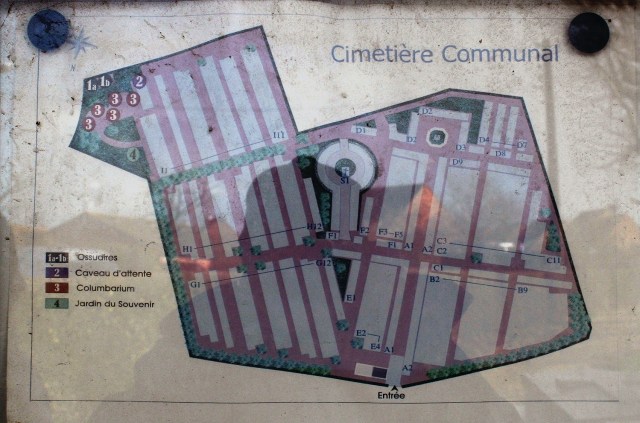A short distance east of Wervicq-Sud, Bousbecque, still only ten miles from the centre of Ypres (Ieper), is another French town that clings to the southern bank of the River Lys, and another place that I have passed by on more occasions than I can remember, without the chance to stop. Until now, that is.
I wanted to visit the communal cemetery to see the town war memorial, which happens to be within, but I didn’t realise, because I had failed to check, that there were British graves here too.
From the entrance, the cross directly ahead of us (below) turns out to be a red herring,…
…because it’s this cross we are looking for. And by over-exposing this shot taken straight into the sun, you can at least see the six CWGC headstones, three on either side, that flank the walkway leading to the memorial.
And here they are with the sun now behind us. Beyond the British graves in this shot,…
…there are French war graves, five on each side,…
…all of which are Second World War casualties.
Two of the British burials on the west side are pilots, the third, on the right, a private of the North Staffs who died, presumably a prisoner, in May 1916.
The two airmen, one Royal Naval Air Service, hence the anchor emblem on his headstone, and one R.F.C., were both killed in action. On 17th July 1917, Flight Sub-Lieutenant Donald Wynyard Ramsay (pictured), aged 20, and two other British airmen, were escorting a fourth, reconnaissance, plane, when they were pounced upon by German scouts, all four British planes being shot down, Ramsay crashing behind the German lines near Wervik. He was flying a Sopwith Triplane, the same plane with which he had scored his only victory, an Albatross Scout, on 27th May 1917. The headstone in the centre is that of Second Lieutenant W. L. Mills, who first arrived in France with the 5th Division Ammunition Column in June 1915, transferring briefly to 4th Division before serving with 127th Brigade, Royal Field Artillery, between August & December 1915, hence the R.F.A. on his headstone (although it has a Royal Flying Corps emblem). He began training as an observer with the R.F.C. in January 1916 and saw action before at some point returning to England to train as a pilot. Unfortunately, he never got the opportunity to test his newly-acquired skills; on his return to France, he was shot down and killed during his first major patrol.
On the other, east, side, two privates of the Royal Fusiliers and a Cheshire Regiment corporal,…
…casualties from 1916 & 1917, and once again presumably prisoners-of-war at the time of their deaths.
Which brings us to the memorial,…
…ringed by more French war graves, although this time all Great War burials,…
…their names listed on the Great War Roll of Honour.
There are French graves from every year of the war round the memorial, beginning here with casualties from 1914 & 1915,…
…and here 1915 & 1916.
The graves continue with men killed in 1915 & 1918,…
…and, er, hm, there are some more here, too!
Continuing with the French graves,…
…these men killed in 1914 & 1918,…
…these in 1914, 1915 & 1917,…
…these in 1915 & 1916,…
…and the final four in 1914, 1917 & 1918.
Now, you might think that’s it, but actually, it isn’t, because if we turn round and look the other way,…
…past Baldrick & the Bins (new album out in March), there just happens to be one of these next door,…
…which we’d better take a look around next post.







































Another very interesting spot. Do you perchance know if the French standardised their headstones? Working from memory here (which is never quite as reliable as I’d like to think), they are different in design to those I saw at Louvencourt
Good point. Pretty certain they didn’t, at least not in communal cemeteries. However, the tilted French helmet is a not uncommon motif on French memorials and headstones, I think. Like you, if memory serves………